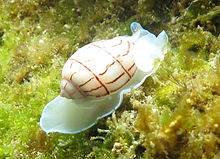
Back الخيشوميه ARZ Opisthobranchia BS Opistobranquis Catalan Zadožábří Czech Hinterkiemerschnecken German Opisthobranchia Spanish Tagalõpuselised Estonian Opistobrankio Basque پشتآبششان Persian Takakiduskotilot Finnish
| Opisthobranchia Temporal range:
| |
|---|---|

| |
| Notodoris minor | |
| Scientific classification | |
| Domain: | Eukaryota |
| Kingdom: | Animalia |
| Phylum: | Mollusca |
| Class: | Gastropoda |
| Subclass: | Heterobranchia |
| Informal group: | Opisthobranchia Milne-Edwards, 1848 |
| Included groups | |
|
clade Cephalaspidea | |
Opisthobranchs (/əˈpɪsθəˌbræŋks, -θoʊ-/[2]) is a now informal name for a large and diverse group of specialized complex gastropods which used to be united in the subclass Opisthobranchia. That taxon is no longer considered to represent a monophyletic grouping.[3]
Euopisthobranchia is a taxon containing a revised collection of opisthobranchs, and that taxon is considered monophyletic. Euopisthobranchia does not include some "traditional" opisthobranchs such as the Sacoglossa and the Acochlidiacea.[4] The subclass Heterobranchia now contains all the species which used to be assigned to Opisthobranchia, plus all the species in the Pulmonata.
The subclass Opisthobranchia included species in the order Cephalaspidea (bubble shells and headshield slugs), the sacoglossans, anaspidean sea hares, pelagic sea angels, sea butterflies, and many families of the Nudibranchia.[3]
Opisthobranch means "gills behind" (and to the right) of the heart. In contrast, Prosobranch means gills in front (of the heart). Opisthobranchs are characterized by two pairs of tentacles and a single gill behind and to the right of the heart. With the lack of a heavily mineralized shell, there has been very little fossil record of the group. However, molecular clock studies have suggested that Opisthobranchia emerged as early as the Carboniferous.[5][6]

- ^ Jensen, K. R. (1997). "Evolution of the Sacoglossa (Mollusca, Opisthobranchia) and the ecological associations with their food plants". Evolutionary Ecology. 11 (3): 301–335. doi:10.1023/A:1018468420368. S2CID 30138345.
- ^ "Opisthobranch". Lexico UK English Dictionary. Oxford University Press. Archived from the original on 26 August 2022.
- ^ a b Cite error: The named reference
Bouchet 2005was invoked but never defined (see the help page). - ^ Cite error: The named reference
Jörger 2010was invoked but never defined (see the help page). - ^ (in Czech) Pek I., Vašíček Z., Roček Z., Hajn. V. & Mikuláš R.: Základy zoopaleontologie. – Olomouc, 1996. 264 pp., ISBN 80-7067-599-3.
- ^ Medina, Mónica; Lal, Shruti; Vallès, Yvonne; Takaoka, Tori L.; Dayrat, Benoît A.; Boore, Jeffrey L.; Gosliner, Terrence (1 March 2011). "Crawling through time: Transition of snails to slugs dating back to the Paleozoic, based on mitochondrial phylogenomics". Marine Genomics. 4 (1): 51–59. doi:10.1016/j.margen.2010.12.006. ISSN 1874-7787. PMID 21429465.